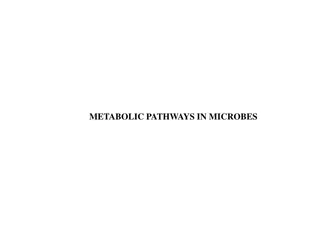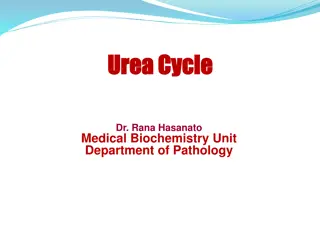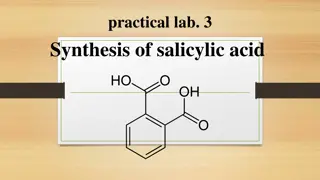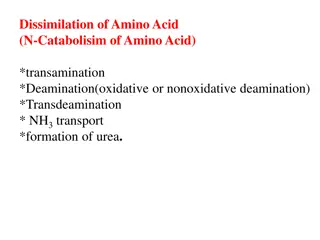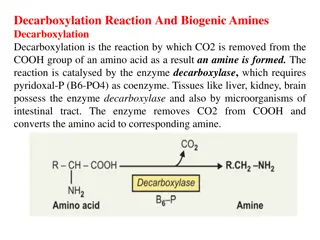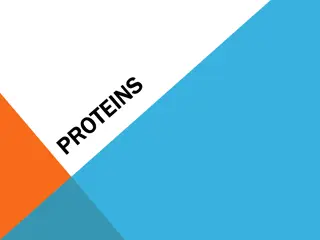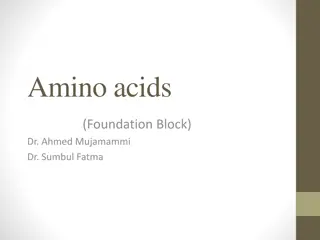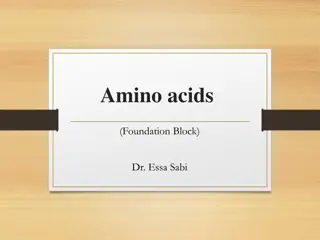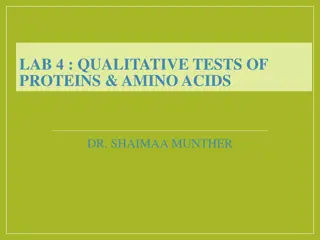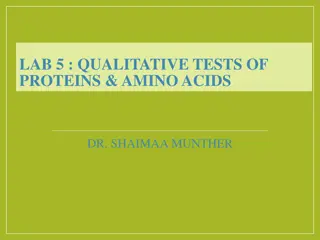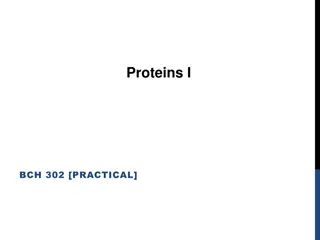Amino Acid Catabolism: Pathways and Reactions
Amino acid catabolism involves removing amino groups via deamination, leading to urea synthesis and TCA cycle intermediates. The process includes transamination and oxidative deamination reactions, with specific aminotransferases catalyzing these reactions. Transamination is a key step in funneling nitrogen from amino acids, except for lysine, threonine, and proline. Pyridoxal-5-phosphate, a derivative of vitamin B6, plays a crucial role in aminotransferase reactions by transferring amino groups.
Download Presentation

Please find below an Image/Link to download the presentation.
The content on the website is provided AS IS for your information and personal use only. It may not be sold, licensed, or shared on other websites without obtaining consent from the author.If you encounter any issues during the download, it is possible that the publisher has removed the file from their server.
You are allowed to download the files provided on this website for personal or commercial use, subject to the condition that they are used lawfully. All files are the property of their respective owners.
The content on the website is provided AS IS for your information and personal use only. It may not be sold, licensed, or shared on other websites without obtaining consent from the author.
E N D
Presentation Transcript
BIOCHEMISTY Course No.-DTC-111, Credit Hours 2 (1+1) AMINO ACID CATABOLISM AMINO ACID CATABOLISM BINITA RANI ASSOCIATE PROFESSOR (DAIRY CHEMISTRY) FACULTY OF DAIRY TECHNOLOGY S.G.I.D.T., BVC CAMPUS, P.O.- BVC, DIST.-PATNA-800014
Catabolism of the amino acids => removing amino group => urea synthesis. Carbon skeletons => TCA => CO2 & H2O or gluconeogenesis. Catabolic Pathway of Amino Acids 3 Common Stages: Removal of alpha-amino group => amino acids (amino acid deamination) => amino group => ammonia. ammonia => urea. amino acid s carbon skeletons => common metabolic intermediate.
Amino Acid Deamination involve two types of biochemical reactions: Transamination and oxidative deamination.
Transamination dominant reactions => removing amino acid nitrogen =>transaminations. these reactions => funnel nitrogen of all free amino acids => small no. of compounds => either oxidatively deaminated => ammonia => or their amino groups => urea by urea cycle. Transaminations => moving -amino group => donor -amino acid => the keto C of acceptor -keto acid => -keto derivatives of amino acid and corresponding amino acid.
All amino acids participate in transamination during catabolism except lysine, threonine and proline . Transamination => readily reversible. catalyzed by aminotransferase (transaminase). Each aminotransferase => specific for one or at most a few amino group donors. named after specific amino group donor, as acceptor is almost always -ketoglutarate => aminated to glutamate
Aminotransferases require => aldehyde-containing coenzyme, pyridoxal-5-phosphate, a derivative of pyridoxine (vitamin B6 ). Pyridoxal-5-phosphate => covalently attached to enzyme via a schiff base linkage <= condensation of its aldehyde group with -amino group of lysine residue. Aminotransferases => transferring amino group of an amino acid => pyridoxal part of coenzyme => pyridoxamine phosphate. pyridoxamine reacts => with an -keto acid => amino acid and => regenerates original aldehyde form of the coenzyme.
glutamate and- ketoglutarate => most common compounds => as a donor/acceptor pair => transamination reactions => participate in reactions => many different amino transferases. All the amino nitrogen => amino acid that undergo transamination=> concentrated in glutamate => because L- glutamate is the only amino acid that => undergoes oxidative deamination at an appreciable rate.
Glucose-alanine cycle skeletal muscle => excess amino groups => transferred=> pyruvate=> alanine => enters => liver => undergoes transamination => pyruvate => gluconeogenesis => glucose => returned => muscles => glycolytically degraded => pyruvate.
Oxidative deamination Transamination => does not result => net deamination. During oxidative deamination, amino acid => keto acid (removal of amine functional group => ammonia and amine functional group => replaced by ketone group) ammonia => urea cycle. glutamate (recipient of amino groups from many sources) => sheds it as => ammonia => excretion
a- ketoglutarate => recycle as nitrogen acceptor => enter TCA cycle or serve as => precursor => gluconeogenesis Deamination occurs through oxidative deamination of glutamate by glutamate dehydrogenase glutamate dehydrogenase is allosterically inhibited by GTP and NADH and activated by ADP and NAD+. The reaction requires an oxidizing agent NAD+ or NADP+.
Urea Cycle Living organisms excrete => excess nitrogen <= metabolic breakdown of amino acids in one of three ways: aquatic animals => ammonia. Where water is less plentiful => processes have evolved => convert ammonia to less toxic waste products => require less water for excretion. one such product is urea and other is uric acid.
Accordingly, living organisms are classified as : ammonotelic (ammonia excreting), ureotelic (urea excreting) or uricotelic (uric acid excreting). Urea is formed <= ammonia, CO2 and aspartate => cyclic pathway => urea cycle.
Urea cycle => discovered by Krebs and Henseleit So => Krebs Henseleit cycle. Urea synthesis : in the hepatocytes (liver cells) consists of five sequential enzymatic reactions. First two reactions => mitochondria and remaining three reactions => cytosol
Urea cycle => formation of carbamoyl phosphate => mitochondria. Substrates ( NH4+ and HCO3-) => catalyzed by carbamoyl phosphate synthetase I (CPSI). Reaction is essentially irreversible => two molecules of ATP are required : one to activate HCO3- and the second molecule => to phosphorylate carbamate.
Carbamoyl phosphate => with ornithine => citrulline => passes into cytosol. Next three steps => occur in cytosol => formation of argininosuccinate by ATP dependent reaction of citrulline with aspartate. (aspartate provides second nitrogen that is ultimately incorporated into urea). Formation of arginine from argininosuccinate. This reaction => fumarate => critic acid cycle. Formation of urea and regeneration of ornithine.
Net reaction of urea cycle : CO2 + NH4+ + Aspartate + 3ATP + 2H2O Urea + Fumarate + 2ADP + AMP i.e. four high energy phosphates are consumed in the synthesis of one molecule of urea .








